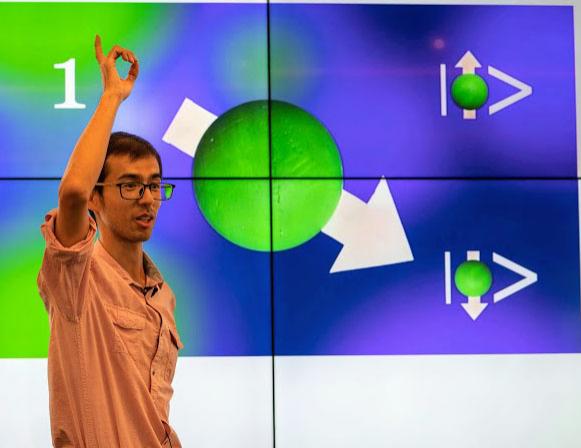Applications
 Part of the Oxford Instruments Group
Part of the Oxford Instruments Group
Expand
Collapse
Oxford Instruments is delighted to announce that Dr Sheng Ran of University of Maryland/NIST has been selected as the winner of the 2020 Lee Osheroff Richardson (LOR) Science Prize.


Dr Sheng Ran is recognised for his research on unconventional superconductivity and electronic phases, particularly his seminal contributions to the discovery of exotic and extremely high-field re-entrant superconductivity in uranium ditelluride.
"Re-entrant superconductivity in such high magnetic field is an extremely rare quantum phenomenon and I feel very lucky to be the one to observe it, and to be the recipient of the Lee Osheroff Richardson Prize", commented Dr Ran.
Sheng has a long history of working on quantum materials. In the field of iron superconductors, he made a breakthrough in the synthesis of CaFe2As2, known for its spectacular volume collapse as a function of applied pressure. Sheng discovered that single crystals of FeAs-flux grown CaFe2As2 could be stabilized in the collapsed phase at ambient pressure, which opened the door to the first ARPES and inelastic neutron scattering studies. Sheng has also added to our understanding of the enigmatic Hidden Order phase in heavy fermion URu2Si2. By chemically tuning single crystals via Fe substitution and performing thermal expansion measurements and transport measurements in high magnetic field, he uncovered important differences between the hidden order phase and a competing antiferromagnetic phase, offering insight into the underlying physical mechanisms.
The discovery of exotic spin-triplet superconductivity in UTe2 is a thrilling experimental development. This remarkable superconducting phase has the highest transition temperature among spin-triplet superconductors of 1.6 K and has incredibly large, anisotropic upper critical field values, up to 35 T. Of particular interest is that this superconductivity also appears to have nontrivial topology. Topology-driven quantum information science is currently at the heart of the National Quantum Initiative Act in the US. While there are many theoretical proposals for using spin-triplet superconductors in devices for quantum information, there are a limited number of unambiguous spin-triplet superconductors supported by concrete experimental evidence. UTe2 adds another member to this very short list.
This discovery was published in Science in August 2019 and is already having a huge impact on quantum materials and quantum information research. An international experimental race was actually begun earlier by the preprint on arXiv well before the date of publication. UTe2 is a worldwide phenomenon, and it has caught the condensed matter physics community’s attention because of its potential as an intrinsic topological superconductor. It is possible that UTe2 will replace Sr2RuO4 as the spin-triplet superconductor archetype. Sheng has been invited to international workshops and conferences to present these exciting results.
Perhaps even more extraordinary is the discovery of an unprecedented, ultra-high magnetic field reentrant superconducting phase, published in Nature Physics in October 2019 (online). Whereas magnetic fields typically limit superconductivity, in this case, magnetic fields induce superconductivity between 40 T and 65 T. These are such high magnetic fields that the physical mechanism behind the stability of superconductivity is currently a very open question. “The discovery of this ‘Lazarus superconductivity’ at record-high fields is likely to be among the most important discoveries to emerge from this lab in its 25-year history,” according to National High Magnetic Field Laboratory director Greg Boebinger.
Sheng has been involved in every aspect of this research. He chemically synthesized the single crystals, oriented and prepared samples, and performed most of the initial structural and electronic property characterization. He travelled to the National High Magnetic Field Laboratory and NIST to perform numerous high-field and neutron scattering measurements. He then performed the data analysis and wrote the manuscripts.
Sheng Ran, Chris Eckberg, Qing-Ping Ding, Yuji Furukawa, Tristin Metz, Shanta R. Saha, I-Lin Liu, Mark Zic, Johnpierre Paglione and Nicholas P. Butch, “Nearly ferromagnetic spin-triplet superconductivity”, Science, Vol. 365, Issue 6454, pp. 684-687, (2019).
This paper reports the discovery of the new spin triplet superconductor UTe2. This paper and its preprint attracted immediate attention from the international research community and started a new stream of research in topology-driven quantum information science. The results were highlighted by NIST and covered by several popular scientific news outlets. Sheng is first author of the paper and conducted the majority of the research.
Sheng Ran, I-Lin Liu, YunSuk Eo, Daniel J. Campbell, Paul Neves, Wesley T. Fuhrman, Shanta R. Saha, Chris Eckberg, Hyunsoo Kim, Johnpierre Paglione, David Graf, John Singleton and Nicholas P. Butch, “Extreme magnetic field-boosted superconductivity”, Nature Physics 15, 1250–1254 (2019).
This paper reports the discovery of two record-breaking high magnetic field superconducting phases in UTe2, one of which exists in the highest magnetic field range identified for any re-entrant superconductor. These discoveries have further implications for topological superconductivity and the study of fault-tolerant quantum computing. Also, these discoveries reflect a new kind of exotic superconductivity rooted in magnetic fluctuations and boosted by a quantum dimensional crossover. The results were highlighted by the NHFML and UMD and covered by several popular scientific news outlets. Sheng is first author of the paper and conducted the majority of the research.
Lin Jiao, Sean Howard, Sheng Ran, Zhenyu Wang, Jorge Olivares Rodriguez, Manfred Sigrist, Ziqiang Wang, Nicholas Butch, Vidya Madhavan, “Microscopic evidence for a chiral superconducting order parameter in the heavy fermion superconductor UTe2”, Nature (accepted 2019).
This paper reports the discovery of chiral in-gap states UTe2 via studies of scanning tunneling microscopy. These results suggest that the superconducting state has a nontrivial topology, and therefore has potential for use in quantum information. Sheng synthesized and oriented the samples.
Shyam Sundar, S. Gheidi, K. Akintola, A. M. Côté, S. R. Dunsiger, Ran, N. P. Butch, S. R. Saha, J. Paglione, and J. E. Sonier, “Coexistence of ferromagnetic fluctuations and superconductivity in the actinide superconductor UTe2,” Phys. Rev. B 100, 140502(R) (2019).
This paper reports muon spin relaxation measurements on UTe2, which reveal strong dynamic low-temperature spin fluctuations, consistent with proximity to a ferromagnetic instability. These results suggest a relationship to the ferromagnetic superconductors, in which magnetic interactions are responsible for superconducting pairing. Sheng synthesized and oriented the samples.
Tristin Metz, Seokjin Bae, Sheng Ran, I-Lin Liu, Yun Suk Eo, Wesley T. Fuhrman, Daniel F. Agterberg, Steven Anlage, Nicholas P. Butch, and Johnpierre Paglione, “Point-node gap structure of spin-triplet superconductor UTe2,” Phys. Rev. B (R – in press 2019).
This paper reports thermal conductivity and magnetic penetration depth measurements on UTe2, showing that the superconducting gap is nodal and consistent with spin-triplet pairing. Sheng synthesized and oriented the samples and performed electrical transport measurements.
Sheng Ran, Inho Jeon, Naveen Pouse, Alexander J. Breindel, Noravee Kanchanavatee, Kevin Huang, Andrew Gallagher, Kuan-Wen Chen, David Graf, Ryan E. Baumbach, John Singleton, and M. Brian Maple, “Phase diagram of URu2-xFexSi2 in high magnetic fields”, Proc. Natl. Acad. Sci., 114, 9826-9831 (2017)
This paper reports the field-temperature-composition phase diagram of Fe-substituted URu2Si2, establishing a single relation between the transition temperature and the critical magnetic field for the mysterious Hidden Order phase, imposing constrains on theoretical explanations. The results were highlighted by NHMFL. Sheng is the first author and performed the majority of the research.
Ran, S. L. Bud’ko, D. K. Pratt, A. Kreyssig, M. G. Kim, M. J. Kramer, D. H. Ryan, W. N. Rowan-Weetaluktuk, Y. Furukawa, B. Roy, A. I. Goldman, and P. C. Canfield, “Stabilization of an ambient-pressure collapsed tetragonal phase in CaFe2As2 and tuning of the orthorhombic-antiferromagnetic transition temperature by over 70 K via control of nanoscale precipitates”, Physical Review B, 83, 144517 (2011)
This paper reports a remarkably large response of the transition temperature of CaFe2As2, a parent compound of Fe based superconductor, to the post growth thermal treatment. These results provide a new control parameter to tune the ground state of Fe based superconductors, inspiring many subsequent studies (cited over 100 times). Sheng is the first author, synthesized samples and performed most of the characterization.